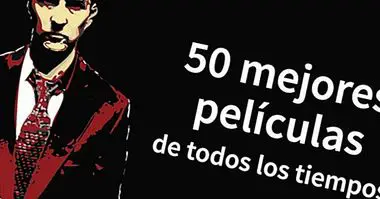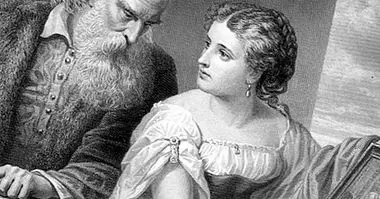10 Brazilian legends based on the history of their cultures
Brazil is a beautiful land, with a rich history and culture in which the heritage of the pre-Columbian and indigenous peoples is mixed with the influence of European cultures. There are many Brazilian myths and legends that have emerged with the passage of time, which aim to give an explanation to the world, reality and the different phenomena and events that worried or astonished its inhabitants.
In order to exemplify and show the folklore of said land, throughout this article we will see a dozen of different Brazilian legends .
- Related article: "10 short Mexican legends based on folklore"
A dozen Brazilian legends
Here we present a dozen Brazilian myths and legends, many of them dealing with the origin of natural elements and / or phenomena such as rainbows, nightmares, some fruits or animals or even elements of the religious beliefs of their natives.
1. The birth of the night
One of the phenomena that has always called attention to all cultures and on which these have always sought an explanation is the arrival of the night, and the pre-Columbian legends of the tribes that populated Brazil are not the exception.
Legend has it that at the beginning of time there was only the day, but one day the daughter of the Big Cobra told her husband that she wanted to see the night . Even though her husband told her that she did not exist, she insisted that she did and that her father kept her. The husband sent his employees home to the Cobra Grande in search of the night.
The Big Cobra decided to satisfy the will of her daughter, giving the employees of this a coconut of tucumán in which it housed it but warning them not to open it or otherwise everything would get dark. However, on the return trip the curiosity could and did not comply with the god's recommendation, opening the coconut and causing the darkness to appear .
Along with her would appear the creatures of the night and various animals. Only the daughter of the Big Cobra would understand what had happened, deciding to put an end to the darkness tearing a hair and passing it through the middle of it: this action would separate the light from the dark and would make the day come back, but as a result that henceforth half of the time was daytime and the other half night, the current succession was born between both moments. In addition, the employees were punished, being transformed into monkeys.
2. The Iguazu Falls
There are also many legends that tell us about the history of the emergence of different geographical features of Brazil . One of them is the legend of the Iguazu Falls.
This legend tells us that the gigantic serpent Boi lived in the Iguazú river, to which the Guaraní natives offered a young woman a sacrifice which they threw into the river. However, on one occasion a man named Tarobá fell in love with the young Naipí, who was to be the sacrifice of that year.
Tarobá, who had previously tried to convince the village elders not to sacrifice her, decided to take a canoe and kidnap the girl to save her. The great serpent, furious at the abduction of what was to be their sacrifice, pursued them and ended up hitting the river, dividing it in two so that Tarobá and Naipí were trapped and creating together with them the falls of Iguazú. The waters that fall from them are the girl's hair, while Tarobá would end up being transformed into a tree . The great serpent watches over them from the bottom, but when the rainbow forms in the falls, both young people meet again.
- Maybe you're interested: "The 10 most interesting and memorable Peruvian legends" ·
3. The legend of Ajuricaba
Some of the legends originating in Brazil also refer to historical phenomena of great relevance, such as the experience on the part of the indigenous population of the arrival and conflicts and struggles with the first Europeans and specifically in this case of the Portuguese. He also tells the story of one of the best-known indigenous leaders of the tribe of Manaós, Ajuricaba.
The legend says that Ajuricaba was born in front of the Negro River, being predicted by his grandfather that he would become the leader of his town and that he would always be protected by the river goddess, Maori. His prowess and warrior spirit were remarkable as a young man. But nevertheless, One day the great ships of the first Europeans arrived in arriving the coasts of Brazil, commanded by Belchior Mendes and with a very superior armament. Conflicts between the two peoples soon broke out, which continued for years.
The Portuguese retired up to five times, but knowing that they would return Ajuricaba's grandfather would give him the command of the fight. Ajuricaba would use multiple ambushes and fight with courage, but in one of the battles would be finally taken prisoner and chained by the Portuguese, who planned to use it as a war trophy and take it to Portugal. However, before reaching it Ajuricaba decided to die: he threw himself into the river, in the hands of the goddess that his grandfather predicted would protect him. It is said that on full moon nights a white canoe can still be seen on the river , in which Ajuricaba travels.
4. The legend of the Amazon River
The Amazon is the longest and mightiest river in the world, being an important source of water and life for the territories for which it passes, including Brazil. In this land there is also a legend regarding its origin.
Legend has it that at a time when animals could not talk yet, the Sun and the Moon fell in love with each other. However, soon both were aware that their love was impossible , since its closeness caused the destruction of the other: while the Moon extinguished the Sun it melted the Moon.
And not only that, but their union would cause floods that would end with the Earth. This would eventually make them decide to separate, something that would cause the Moon to cry inconsolably for days. Their tears arrived at the planet, but the fact that they were fresh water would cause that they were rejected by the sea, in such a way that they would end up transforming themselves into a gigantic river: the Amazon.
5. Curupira, the guardian of the forest
The Brazilian indigenous tribes greatly valued the importance of the forest and forests, which have their own creature / deity protector. We are talking about the legend of the Curupira, typical of the Tupi.
This powerful being is small but has great strength and speed , it is usually described as bald or red-haired and with large ears and one of its most distinctive characteristics is the fact that it has the feet inverted (that is, looking towards the back instead of toward the front).
It is a protector of trees, animals and nature, often making you lose yourself and forget the way back to those who invade and harm you as punishment.
Hunters and woodcutters are often their enemies, interrupting their activities (although tolerating the hunt in those who carry out hunger). Due to the inversion of his feet, his prints are also extremely confusing, something that makes it difficult to find him. It is also said that children are sometimes taken into the woods to teach them how to love them, returning them to their families when they reach seven years of age.
6. The Pisadeira
One of the legends of Brazil tells us about the creature known as the Pisadeira, which is considered the physical representation of nightmares .
This creature has the body of a skeletal old woman, with long, yellowish nails, a hawk's nose, and an open mouth from which only horrible laughter emerges that only those she chooses can hear. It is said that this creature stalk people from the rooftops , jumping on the chest of the sleeping ones (especially after drowsiness after dinner) and generating a suffocation that paralyzes its victim.
She is aware of what is happening, but is not able to move or react and will often have the sensation of drowning and about to die when she wakes up. La Pisadeira may find the situation more fun as the person becomes more afraid, and may prolong and repeat their attack.
7. The legend of Guaraná
Among the many myths and legends existing in Brazil, we can find many that refer to the origin of food from these lands. One of them is the one that speaks of Guaraná.
Legend has it that an indigenous couple of the Maués tribe had lived together for years and wished they had children , not having succeeded in generating. On one occasion, they asked the god Tupá to grant them this grace, something to which the god responded by giving them a healthy and good son who, as time went on, grew.
But the god of darkness Jurupari began to envy the child and his strength, peace and happiness , taking the decision to end it: at a time when the child went to collect fruit the god turned into a snake and bit him, killing him with his poison. The parents were left desolate, but the god Tupá sent a storm that the mother understood as an indication that she should plant the eyes of this one: from them would be born a plant capable of giving strength and vigor. In doing so, the afflicted parents discovered that guarana would be born from the eyes of their son, whose seeds in fact resemble that of human eyes.
8. The legend of Açaí
Although not well known in the West, açaí is the fruit of a palm tree of great importance to the peoples of the Amazon and of great relevance in the territory of Brazil. This fruit is consumed since pre-Columbian times, and there is a sad legend regarding its origin.
The legend tells how a long time ago a tribe located in the river Pará suffered a time of great shortage, with what the continued growth of the population supposed a serious danger for the survival. Due to the critical situation the leader, named Itaki, would agree with the tribe's advice that from now on any baby that was born would be sacrificed . However, one day her daughter Iaçá became pregnant and would give birth to a girl. The council demanded that the agreement be complied with, something that Itaki would agree to despite Iaçá's pleas.
After the death of the little Iaçá she would spend days locked in her tent, praying to the god Tupá so that the village leader could learn a way to fix the situation without having to die more children. At night, the woman heard a cry, which she followed to a palm tree. There he saw his daughter, smiling, rushing to hug her. However, when he touched her he only found the palm tree, something that would make her hug her sadly.
However, the next day the woman woke up, still embraced, dead but happy while looking at the leaves of the palm tree. Seeing the body and the direction of his gaze, his father Itaki discovered some small fruits, the açaí, from which wine could be obtained. The birth of these fruits caused that his town could have food, something that in turn would cause the sacrifices to cease to be unnecessary. Fruits received the reverse name of the leader's daughter, Açai.
9. The legend of uirapurú
One of the birds whose origin has been represented by the legends and myths of the original peoples of Brazil is the uirapurú. This bird of beautiful song was held by a magical and supernatural being , to the point that their feathers are a lucky charm when it comes to love.
According to the legend that tells us its origin, there was once a tribe in which two women had fallen in love with the same cacique, who had to choose one to make her his wife. The cacique decided that the chosen one would be the one with the best marksmanship, establishing an archery test of which one of them was the winner. The other woman, named Oribici, cried disconsolately and he prayed to the god Tupa to transform it into a tree in such a way that he could continue to see his beloved without his knowledge.
The god thus did it, something that made it possible for Oribici to witness little by little how his beloved was happy and deeply in love with his wife. The young woman decided to go north, where Tupá seeing her sadness made her small and gave her the gift of singing in order to help her relieve her pain. Thus, he transformed it into the uirapurú.
10. Yasá and the origin of the rainbow
This legend tells how a young girl from the Cashinahua tribe, Isa, was so beautiful that the god Tupá fell in love with her , something to which she corresponded, reaching both to form a couple in love and happy. However, the demon Anhangá would also notice the girl, who, in order to prevent her from committing herself to Tupá and getting her love, would go to the woman's mother with the purpose of asking for her hand, offering in exchange all the food that you will need for the rest of your life if it was granted. The mother agreed to the deal, and she must then marry the Anhangá and separate from Tupá.
Isaiah asked her future husband to grant her the desire to see her beloved Tupa again before agreeing to marry and live in the underworld. The devil accepted but would put a condition: cut in the arm in order that the blood created a path that could follow.
Knowing this and in order to mislead Anhangá, Tupá would try with the help of the gods of the Sun, the Sky and the Sea to create different strokes of different colors (yellow, sky blue and navy blue respectively) that made the devil lose the Track of Isa The woman, however, would lose strength while losing blood, to the point of falling to the ground and dying on the beach, not getting to reencounter with his beloved. The mixture of his blood and the dust of the sand that would arise from his collision with the ground would also form orange, violet and green strokes. The set of all these traces would form the first rainbow.
Bibliographic references:
- Gómez, A.M. and Palma, V. (2011). Legends of the Brazilian Amazon. Orellana Collection, 22. Technical General Secretariat. Ministry of Education. Embassy of Spain in Brazil.



















